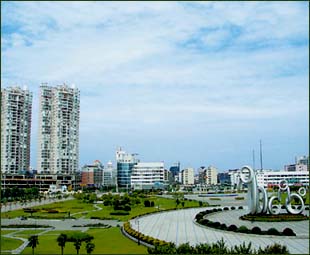| Home / Environment / International Cooperation | Tools: Save | Print | E-mail | Most Read |
| Joint Project Helps Reduce Carbon Dioxide Emissions |
| Adjust font size: |
An international project has helped cut 1.1 million tons of carbon dioxide emissions in China annually by encouraging township and village enterprises (TVEs) to adopt energy efficient technologies. These "green" TVEs are mostly in the cement, brick, coking and metal casting sectors, which are estimated to be responsible for one-sixth of China's total carbon emissions, said the project's initiators with the United Nations Development Programme (UNDP) and the Ministry of Agriculture. The achievement was announced yesterday at an international forum on rural energy efficiency held in Hangzhou, east China's Zhejiang Province. It was a successful demonstration of how TVEs in developing countries can transform from heavy polluting and energy consuming to clean and energy efficient roles, said Khalid Malik, UN resident coordinator in China. UNDP statistics show that TVEs, which account for 30 percent of China's gross domestic product, consume 30 to 50 percent more energy on average than State-owned enterprises using new technologies. The US$18.5 million project started with nine pilot sites in Shaanxi, Sichuan and Zhejiang provinces, and spurred the replication in 118 TVEs nationwide, with 400 more expected to follow suit soon. A number of clean technologies have been introduced to the industries through the project, as they help both lower costs and reduce pollution. Zhejiang Shenhe Cement Co Ltd, one of the pilot sites, has reduced about 20,000 tons of CO2 emissions per year by building the country's first waste heat power generation plant, which collects waste heat from the cement kiln to generate electricity for a second utilization. Frank Pool, a New Zealand-based independent sustainable energy consultant, said that its success was attributed to a logical and realistic design, in which national and local governments, TVE bosses and an entrustment loan facility were able to interact coherently. "The project identified that there are still large untapped energy efficiency potentials in the four TVE sectors in China," he wrote in the final evaluation report for the project. "In particular, there is a major challenge remaining to update the 100,000 brick kilns throughout China that provide 95 percent of local rural construction materials."
Improving energy efficiency of TVEs is part of the job to promote rural energy efficiency, which remains one of the priorities the Chinese government is committed now and in the future to curbing greenhouse gas emissions, said Wei Chaoan, vice-minister of agriculture during the forum. "Once the utilization of nitrogen fertilizer is improved by 1 percent, 2.5 million tons of coal equivalent will be saved," he said. (China Daily May 17, 2007) |
| Tools: Save | Print | E-mail | Most Read |
 |
| Related Stories |
|
||||
